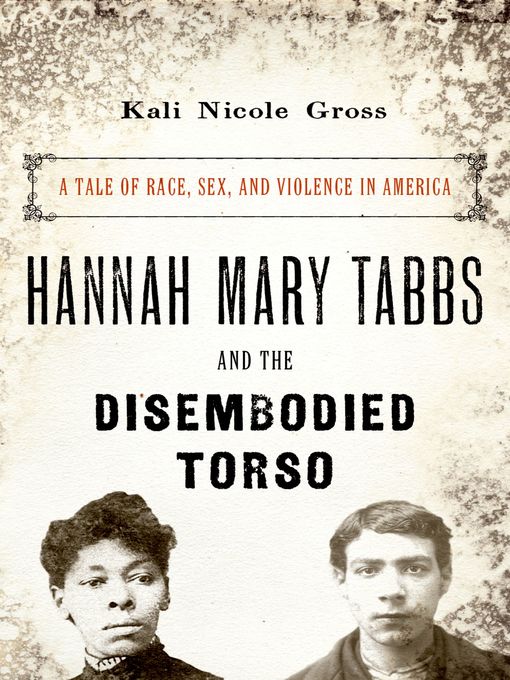
Hannah Mary Tabbs and the Disembodied Torso
A Tale of Race, Sex, and Violence in America
- اطلاعات
- نقد و بررسی
- دیدگاه کاربران
نقد و بررسی

February 15, 2016
In 1887 a dismembered torso is discovered by a pond outside Philadelphia. Investigators eventually focus on two suspects: a black woman named Hannah Mary Tabbs, and her former neighbor George Wilson, whom she implicates after her arrest. As a result of the racial background of the victim and alleged perpetrators--and the sordid details that are revealed throughout the months-long trial--the story catches the attention of the national press. Like many of its kind, however, the case became buried in history. Gross (African studies, Univ. of Texas at Austin; Colored Amazons), a meticulous historian, unearths it here with skilled scholarship and a fascinating re-creation of the facts. She depicts Tabbs, arguably the most compelling figure, in the context of post-Reconstruction America in a way that allows us to view the crime and the media deluge that followed from a wide lens. VERDICT Gross provides disturbing insight into the late 19th century, including the treatment and depiction of African Americans, issues of domestic violence, and the textured currents of race relations, while also providing a compelling story told through thoughtful and skilled narration.--Erin Entrada Kelly, Philadelphia
Copyright 2016 Library Journal, LLC Used with permission.

January 18, 2016
Gross (Colored Amazons: Crime, Violence, and Black Women in the City of Brotherly Love) examines the intersections of race and gender in 19th-century Philadelphia in this dynamic and powerfully rendered account of the 1887 trial of Hannah Mary Tabbs. Tabbs, a black woman known by various aliases who was in an adulterous relationship, was accused of murdering her lover, chopping him up, and bundling the pieces into a package. Gross builds suspense through descriptions of gruesome crime scene and details of witness testimonies, all the while filling the reader in on the intricate racial politics surrounding the case. The dismembered and racially ambiguous torso of the African-American victim and the light-skinned complexion of a second suspect galvanized the police and generated much of the initial news coverage, during an era when many black murder victims were forgotten. Gross's in-depth accounts of the police brutality, forced confessions, and science-based forensics involved in the case feel surprisingly modern.

November 1, 2015
A sordid murder reveals beliefs about race, sex, and justice in post-Civil War Philadelphia. Historian Gross (African and African Diaspora Studies/Univ. of Texas; Colored Amazons: Crime, Violence, and Black Women in the City of Brotherly Love, 1880-1910, 2006) draws on police and prison records, witness testimony, newspapers, and other archival sources to produce a thorough, absorbing examination of the crime, its context, and the two people tried. The discovery of a dismembered torso in a pond near Philadelphia set off an investigation that eventually led to Hannah Mary Tabbs, a 32-year-old married black woman, and 18-year-old George Wilson, "somewhat simple, or 'weak-minded, ' " whom Tabbs blamed for the killing and dismemberment. Unfortunately for Wilson, he was of mixed race, light-skinned enough to be taken for white. "Whereas crime reports typically invoked whiteness to indicate innocence," writes the author, "with victims often described as lighter than assailants, for Wilson it stirred doubt and an undercurrent of hostility." Mixed-race individuals "upended notions of whiteness as distinct and supreme" and incited whites' fears that blacks could circulate undetected or even that whites could mysteriously and horrifyingly turn black. Gross focuses intensely on Tabbs, a woman with a history of violence. Yet because of "her browner skin, pronounced southern drawl, and deferential manner in court," she seemed less threatening than Wilson. The author argues that Tabbs "understood that northern whites wanted to be reassured about the boundaries of whiteness and black subordination to it" and "manipulated the criminal justice system exceedingly well." Gross' insistence that Tabbs "possessed extraordinary physical and intellectual abilities" and "critical skills," however, is not completely persuasive. Just as likely, she was a sociopath--duplicitous, brutal, and incapable of empathy. Although the author's meticulous reconstruction of the case sometimes leads to repetition, she succeeds in conveying the unsettled world in which it occurred.
COPYRIGHT(2015) Kirkus Reviews, ALL RIGHTS RESERVED.




دیدگاه کاربران